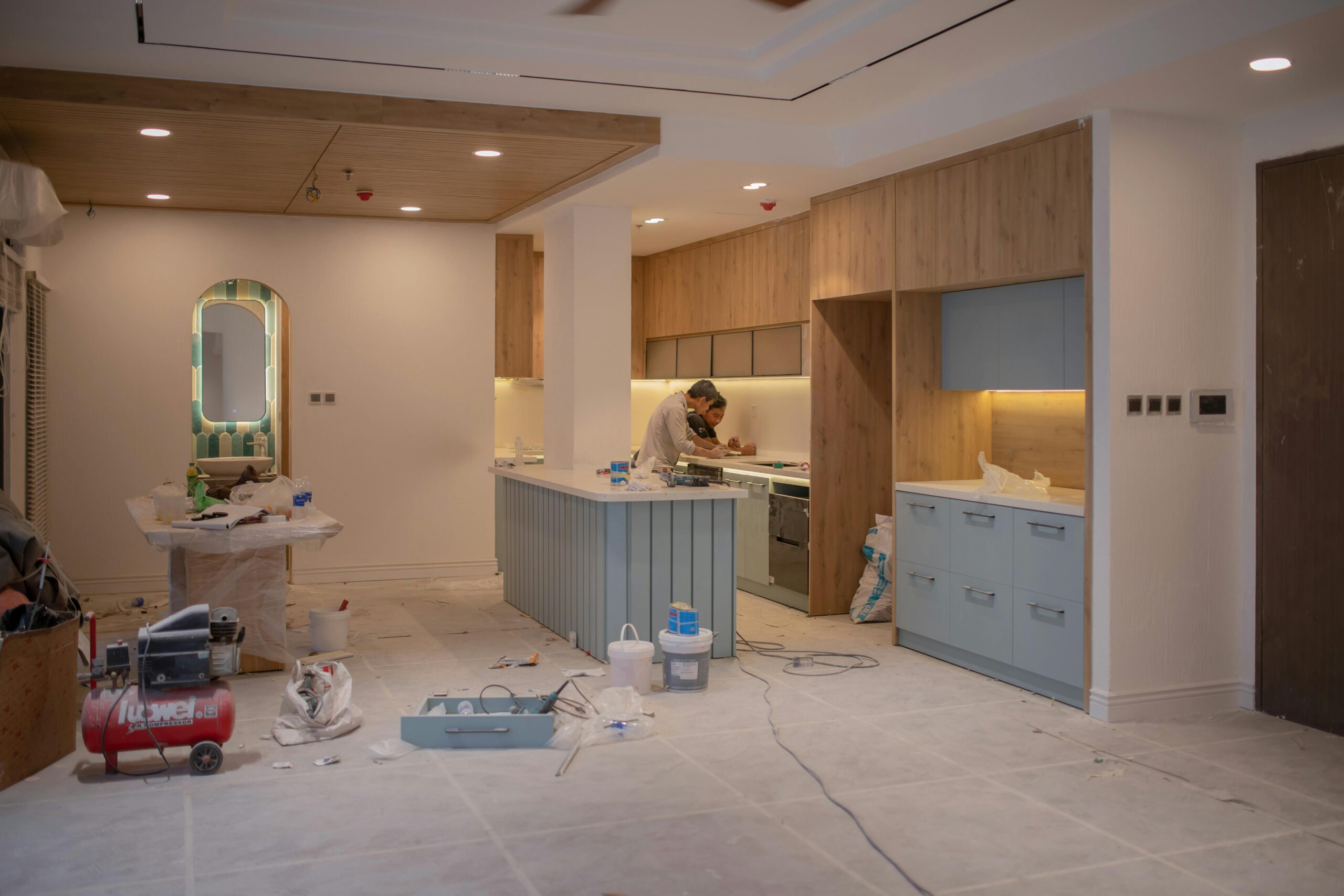HOME IMPROVEMENT
Innovations in Architectural Visualisation

Today, architectural 3D visualisation not only helps to show the customer and client future objects, but also seriously affects marketing, sales and the design process itself. As a type of service, it is actively developing and gaining more and more significant role in the whole real estate sector, provoking the growth of popularity and development of such technologies as virtual and augmented reality.
Virtual and augmented reality in 3D visualisation
Architectural experts predict that these technologies will eventually become mainstream tools in engineering visualisation and design. These technologies allow future buyers to evaluate and walk through an object in 3D space, assess the layout and see if it is suitable for them at the design stage. This not only increases customer engagement, but also builds trust.
The virtual tour will enable the buyer not only to assess the technical parameters of the object, but also to feel the atmosphere of their future home, to visualise the future interior and exterior. Thanks to innovations in augmented reality technology, we are able to superimpose a 3D model on a real place, which is especially important when presenting country houses. If you are in need of 3d exterior rendering services, I recommend you contact the company RenderZen, where you will get the best service for visualization of exteriors.
Artificial intelligence
The ever-deepening integration of artificial intelligence into all engineering and architectural processes is accelerating the creation of 3D visualisations. Today, artificial intelligence can automatically generate 3D visualisations based on drawings, whereas in the past this was a rather time-consuming process, and if the customer was interested, a paid service was usually offered. Now it is not a problem – you can easily, quickly and free of charge provide a potential buyer with a three-dimensional image of the desired object taking into account all his wishes. Imagine how this could affect conversion rates in the construction industry.
The construction and architectural industries are evolving to keep up with modern technology, but thanks to the latest innovations in rendering and artificial intelligence, they have made huge leaps in the last year. Perhaps this will soon be reflected in the streamlining of construction and architectural processes, making the real estate market more accessible.
HOME IMPROVEMENT
How Much Does a MagnaClean Filter Cost Installed?

A MagnaClean filter’s a must-have for keeping your heating system running smoothly. Think of it like a big magnet or MagnaClean filter that grabs all the gunk like sludge, rust, and stuff that can mess up your central heating.
By stopping all that junk from blocking things up, it helps your system run better and can cut down your energy bills a lot. Not only does it make everything work smoother, but it also helps your system last longer, which is great for saving money and staying worry-free in the long run.
Getting a MagnaClean filter’s a smart move if you want your heating to be in top shape and not cost you a fortune.
Factors Influencing MagnaClean Filter Installation Costs
When you’re thinking about putting a MagnaClean filter in your home, a few things can change how much it’ll cost. First off, the type of filter matters. Some have cool extras like stronger magnets or extra layers to clean better, which can bump up the price.
Then there’s how tricky the installation is. If your heating system’s tucked away in a tight spot like a crowded basement or an awkward attic, it’ll take more time and effort, which means more money.
Plus, where you live counts too. In cities, you’re likely to pay more for labor than in the countryside. Knowing all this can help you pick the best option for your needs and wallet.
Average Cost Range for MagnaClean Filters
MagnaClean filters come in different styles, each with its own perks and prices. The basic MagnaClean Professional 2 is usually between £80 and £100, and it’s great for getting rid of sludge and debris in most systems.
If you’re tight on space, check out the MagnaClean Micro 2, which goes for about £100 to £120. It’s small but still works like a charm for flats or smaller homes.
If you’re after top-notch performance, the MagnaClean TwinTech with its dual filters costs £120 to £150, perfect for bigger or more complex systems.
Prices might change depending on where you buy, so it’s a good idea to shop around for the best deal. Also, be aware that extra features like stronger magnets can bump up the price a bit. Have a look around and find what’s right for you!
Installation Costs and Considerations
Considering a MagnaClean filter? It’s handy to know that installation costs can vary quite a bit based on several factors.
The plumber’s expertise and your location play a big role. If your plumber has loads of experience, you might see a higher bill. Plus, living in a bustling city like London or Birmingham could mean steeper prices compared to a peaceful village.
Typically, you’re looking at labour costs ranging from £50 to £200.
Imagine you’re relaxing in a small-town flat; chances are, you’ll pay less. But if you’re in a large house in London with complex plumbing, expect it to be more expensive.
Here’s a friendly tip: gather a few quotes from different plumbers. This way, you can compare prices and get a sense of the services offered.
Hiringa qualified heating engineer is always recommended to ensure the filter is installed correctly and works efficiently right from the start.
You’ll find the best option for your budget and home needs. So, why not start collecting those quotes to ensure everything goes as planned without emptying your wallet?
Ways to Save on Installation Costs
Thinking about getting a MagnaClean filter installed? You can make it happen without breaking the bank if you know where to look for a deal.
Start by checking out local plumbers; they often run promotions, especially during quieter times like mid-week or off-peak seasons.
This could be your chance to snag a bargain. Before you dive in, gather a few quotes to compare prices and make sure you’re not sacrificing quality for cost. It’s wise to ask for a detailed quote, helping you avoid any surprise charges.
And don’t shy away from mentioning a lower price you’ve found elsewhere—some places might be willing to match it.
Keep an eye out for special offers that include extra services at a reduced rate. With these tips, you can save a bit of cash and keep your budget in check while getting your MagnaClean filter installed. Why not give it a try and see how much you can save?
Long-Term Savings Benefits
Installing a MagnaClean filter can be a game-changer for your energy bills because it boosts your heating system’s efficiency.
By capturing all the dirt and grime that typically clogs up your system, it allows everything to run smoother and use less energy. Some folks have actually seen their heating costs go down by a whopping 20-30% after installing one!
And since cleaner systems break down less often, you’re also saving on those dreaded repair bills. So instead of forking out hundreds of pounds on unexpected fixes, your system, with one of these nifty filters, keeps more money in your pocket over time.
But it’s not just about slashing energy use. A MagnaClean filter also helps extend the life of your heating system, meaning you won’t be shopping for a new one any time soon. Just be sure to give the filter a clean every six months to keep everything in top shape.
All in all, adding a MagnaClean filter isn’t just a quick fix; it’s a savvy investment for long-term savings. Why not consider giving it a shot and see the difference for yourself?
Regular Maintenance Checks
Keeping your MagnaClean filter clean is really important. It helps your heating system run smoothly, saving you from unexpected costs.
If you skip regular checks, you might face blockages, poor performance, and higher energy bills. Think of it like your car; ignoring maintenance can lead to bigger issues. Aim to clean the filter every six months to remove any gunk that the magnets might’ve missed.
Here are some cleaning tips:
- Mix a bucket of warm water with white vinegar. This combo tackles stubborn residues much better than water alone.
- Give the magnetic core a careful check since it catches most of the dirt. Even a small amount left behind can cause trouble down the road.
By regularly checking and cleaning your filter, you make sure your system works efficiently and avoid costly repairs. Setting a reminder or linking this task with your other chores, like changing smoke alarm batteries, can help you remember.
This simple upkeep keeps your heating system running smoothly, reduces energy costs, and helps prevent major issues before they start. Why not grab your cleaning supplies and give it a go?
Conclusion
Getting a MagnaClean filter is a smart move that might seem costly at first but saves you money in the long run. Prices can vary depending on the type of filter and how it’s installed, but the perks are obvious.
It cuts down your energy bills and reduces the need for repairs, saving you a good chunk over time. Check out local labour costs and get a few quotes to find the best deal for installation. Keeping up with regular maintenance will make sure your system works its best.
Take some time to think about what you need and your options so you can make the right choice. Why not start planning for your MagnaClean installation to enjoy a comfier and more efficient home?
HOME IMPROVEMENT
How Eco-Friendly Household Products Are Shaping Safer Home Environments

Eco-friendly household products are becoming an important part of modern living. More people now want safe solutions for cleaning and maintaining their homes. These products are made with simple and gentle ingredients. They help reduce harmful chemicals inside homes. They also support a cleaner environment by lowering waste and pollution.
Many families are replacing traditional items with greener options. These new choices focus on safety, sustainability, and long-term health. They cover common needs in every home, from cleaning to purification. Today’s eco-friendly options offer strong performance without causing harm. People can find a wide range of household goods that support a safer lifestyle.
The Growing Demand for Eco-Friendly Home Care Solutions
The demand for eco-friendly home care products is rising quickly. People now understand the risks of strong chemicals that stay in air and surfaces. As science grows, better alternatives appear. These alternatives aim to protect both health and the environment. They also reduce the negative impact of waste and chemical water discharge.
Eco-friendly products are designed for real needs. They help families clean clothes, wash dishes, and maintain surfaces safely. They offer effective cleaning while staying gentle on skin and air quality. These products are also more honest about their ingredients. Clear labels help people make better decisions.
Key Features That Define Safe and Green Household Products
Eco-friendly home care products have clear qualities that separate them from traditional ones. They focus on health, safety, and sustainability. These products are made responsibly. They also help reduce long-term harm caused by chemicals.
Benefits of Using Eco-Friendly Products in Daily Life
Switching to eco-friendly options offers many benefits. Homes become safer and cleaner. People reduce exposure to strong cleaning agents. Families also support a healthier planet. These products make daily tasks easier and safer.
Eco-Friendly Cleaning Products Improving Home Hygiene
Cleaning is a major part of maintaining a healthy home. Eco-friendly cleaners offer strong cleaning power. They use plant-based ingredients and natural minerals. These ingredients break down dirt without releasing harsh fumes.
Some products are created to work on many surfaces. They can clean kitchens, bathrooms, and living areas. They are also designed to rinse off easily. This reduces the risk of residue building up. Safer cleaners make homes more comfortable.
How Water Purification Systems Support a Safer Home
Clean water is essential for health. Water purification systems help remove harmful elements from tap water. They support safe drinking water for daily use. These systems use advanced filtration. They reduce contaminants and unpleasant tastes.
Filtered water helps families cook and drink safely. It also improves the overall quality of life. Homes that use purification systems reduce dependency on bottled water. This decreases plastic waste and supports sustainability.
Technologies Behind Air Purification Solutions
Air quality affects health in many ways. Air purification systems help remove dust, odors, and allergens. These systems use strong filters. They capture tiny particles that normal cleaning cannot remove.
Air purifiers support healthier breathing. They help families who suffer from allergies or asthma. They also reduce pollution that comes from cooking or daily activities. Cleaner air helps people feel better at home.
Exploring Modern Kitchenware Designed for Safer Use
Modern kitchenware is designed with safety in mind. Many products use durable materials. They help families cook food in a safe and healthy way. High-quality cookware distributes heat evenly. This prevents burning and saves energy.
Eco-friendly kitchenware is also built for long life. It reduces the need for frequent replacements. This supports sustainability. Better kitchenware also improves cooking experiences. It makes daily meals easier to prepare.
Advantages of Concentrated Cleaning Products
Concentrated cleaning products are gaining attention. They offer strong cleaning power in small amounts. This reduces waste from packaging. Families can use less product and still get good results.
These concentrates are easy to store and transport. They also last longer. This saves money and reduces the need for frequent purchases. Concentrated formulas lower environmental impact and support responsible living.
How Eco-Friendly Laundry Solutions Protect Fabrics and Skin
Laundry products can affect skin and fabric health. Eco-friendly laundry options use gentle ingredients. These ingredients help protect clothing fibers. They also reduce irritation on sensitive skin.
These products also break down easily in water. They reduce pollution in drainage systems. Safe laundry detergents help maintain both clothing quality and environmental health.
What To Look for When Choosing Safe Household Products
When choosing eco-friendly options, several features matter. Families should look for clear labels. Ingredients should be easy to understand. Products should also be tested for safety. Companies that share their process are often more trustworthy.
Useful Factors to Consider
- Ingredient transparency
- Low chemical content
- Biodegradable formulas
- Long-lasting packaging
- Safety testing details
- Clear usage instructions
The Future of Eco-Friendly Home Care Products
Eco-friendly household products will continue improving. New research supports safer alternatives. Companies now focus more on health and sustainability. Homes will see more advanced systems for cleaning air and water.
More families are also aware of the benefits. They want safe solutions for long-term use. These products will become more common. They will also become more affordable for everyone.
How Cleaner Homes Create Healthier Lifestyles
A clean home supports better health. Eco-friendly choices help remove harmful elements. They also reduce risks from strong chemicals. Families can enjoy safer surroundings every day.
Using better products can improve daily comfort. It can also create healthier habits. Clean air, clean water, and safe surfaces all support well-being. Eco-friendly solutions make this easier.
Why Sustainable Home Care Matters Today
Sustainability is becoming important in every part of life. Eco-friendly products reduce waste. They lower pollution. They support a healthier environment for future generations.
Responsible choices help protect natural resources. They also support cleaner homes. When families choose safer options, they help build a better world.
Conclusion
Eco-friendly household products are shaping safer home environments every day. They offer strong cleaning power while protecting health. They also support a cleaner planet. Families can now use better options for cleaning, cooking, air quality, and water safety.
These products will continue to grow in popularity. They provide a balance of performance and safety. Choosing eco-friendly solutions helps create homes that are cleaner, healthier, and more sustainable.
HOME IMPROVEMENT
Common Thermador Appliance Issues and How Prime Fix Repairs Them in San Francisco

Thermador is a top-tier brand that offers a wide range of luxury kitchen appliances, including refrigerators, ovens, cooktops, dishwashers, and more. Their products are known for being durable, high-quality, and designed to deliver professional-grade performance. However, like all appliances, Thermador products can experience occasional issues that need expert attention. If you’re facing any trouble with your Thermador appliances, Prime Fix Appliances Repair offers fast and reliable solutions in San Francisco and the surrounding Bay Area.
At Prime Fix, we specialize in Thermador appliance repair, offering services that help you get your appliances back in top shape. Whether it’s a refrigerator that’s not cooling properly, an oven that won’t heat, or a dishwasher leaking water, we have the expertise to handle it all. In this article, we’ll cover some of the most common Thermador appliance issues and explain how Prime Fix addresses them to restore your kitchen equipment to optimal performance. You can learn more about the range of services at https://prime-fix.com/brands/thermador/.
Common Thermador Appliance Problems
Even though Thermador appliances are designed for durability, they can experience a variety of issues due to normal wear and tear. These issues can disrupt your kitchen routine, but with professional help, they can be resolved quickly and efficiently. Here are some of the most common Thermador appliance problems and how we at Prime Fix tackle them.
Thermador Oven and Cooktop Not Heating Properly
One of the most common issues with Thermador ovens and cooktops is problems with heating. This issue can affect both gas and electric models. If your oven isn’t heating to the desired temperature, or your cooktop isn’t igniting properly, it can be frustrating, especially when you’re trying to prepare meals for your family.
At Prime Fix, we understand the importance of a fully functioning oven and cooktop in your kitchen. The problem could be due to several reasons, including faulty heating elements, broken ignitors, or a malfunctioning thermostat. Our team of experts will quickly diagnose the issue and get your Thermador oven or cooktop working like new.
Thermador Refrigerator Not Cooling or Inconsistent Temperatures
A refrigerator that isn’t cooling properly is more than just a minor inconvenience. It can cause your food to spoil, which may result in costly waste. If your Thermador refrigerator is experiencing temperature fluctuations or isn’t cooling at all, you need to address the issue as soon as possible.
The problem could be caused by several factors, including issues with the compressor, evaporator fan, or condenser coils. At Prime Fix, we specialize in diagnosing and repairing all types of refrigeration issues, ensuring that your Thermador fridge returns to peak performance. We will check each component and fix the problem swiftly, so you don’t have to worry about spoiled food or energy waste.
Thermador Dishwasher Leaks or Fails to Drain
Another common issue with Thermador appliances is a dishwasher that leaks water or doesn’t drain properly after a cycle. A leaking dishwasher can cause water damage to your kitchen floor and lead to bigger issues if left unaddressed. Similarly, a dishwasher that doesn’t drain can leave dishes dirty and cause unpleasant odors.
Leaks often occur due to worn-out door seals or clogged drain hoses. If your Thermador dishwasher isn’t draining, it could be due to a blocked drain pump, faulty float switch, or clogged drain hose. At Prime Fix, we are equipped to fix these common issues, restoring your dishwasher to full functionality and preventing future leaks or drainage problems.
Thermador Cooktop Ignitor Problems
Thermador cooktops are designed to provide precise heat control, but sometimes the ignitors fail to work correctly. If your cooktop burners won’t light, it could be due to a faulty ignitor or a buildup of debris in the ignition system.
In these cases, Prime Fix can clean or replace the ignitors and ensure the burner is functioning properly. We’ll also check for any gas line issues or blockages that could prevent the cooktop from igniting. Our goal is to restore your cooktop’s efficiency, so you can get back to cooking your favorite meals without delays.
Thermador Oven Door Won’t Close or Seal Properly
A malfunctioning oven door that won’t close properly is another issue that can affect the performance of your Thermador oven. If your oven door is misaligned or the door seal is worn, it can cause heat to escape, leading to uneven cooking or longer cooking times.
Prime Fix technicians can assess the problem with your Thermador oven door and fix it promptly. Whether the issue is a misaligned door, a damaged seal, or a broken latch, we have the tools and experience to get your oven door working properly again.
How Prime Fix Solves These Problems
At Prime Fix, we pride ourselves on offering fast, reliable, and professional repair services for Thermador appliances. When you choose us for your repair needs, you can expect:
- Experienced Technicians: Our team of trained and certified technicians is highly experienced in dealing with Thermador appliances. We have the knowledge to diagnose and repair any issues you may be facing.
- High-Quality Parts: We use only high-quality, manufacturer-approved replacement parts for repairs. This ensures that your Thermador appliance functions like new after the repair.
- Same-Day Service: We understand that a broken appliance can disrupt your daily life. That’s why we offer same-day service, so you don’t have to wait long to get your appliance fixed.
- Professional Repairs: We take pride in offering professional, courteous service. Our technicians will arrive on time, perform the necessary repairs efficiently, and leave your kitchen clean.
Common Thermador Repair Issues We Address
Here are some of the most frequent Thermador appliance issues we repair:
- Ovens and Cooktops Not Heating Properly
- Refrigerators Not Cooling or Inconsistent Temperatures
- Dishwashers Leaking or Failing to Drain
- Cooktop Ignitor Failures
- Oven Door Misalignment or Seal Issues
Why Choose Prime Fix for Your Thermador Appliance Repair?
When your Thermador appliance breaks down, you need a trusted expert to fix it quickly and effectively. Prime Fix Appliances Repair is your go-to solution in San Francisco for fast and reliable Thermador appliance repairs. We offer a range of benefits, including:
- Licensed and Insured Technicians
- Same-Day Emergency Repairs
- Manufacturer-Approved Parts
- Comprehensive Warranty on Services
We are proud to serve the San Francisco Bay Area, including Oakland, Palo Alto, and beyond. Whether you need help with your oven, refrigerator, cooktop, or dishwasher, we’re here to provide the professional repair services you need.
Conclusion
Thermador appliances are built to last, but like all machines, they can experience issues over time. From ovens that don’t heat to refrigerators that don’t cool, these problems can be frustrating. At Prime Fix, we specialize in diagnosing and repairing these common Thermador appliance issues with expertise and professionalism. Whether you need help with your Thermador oven, dishwasher, or refrigerator, we’re here to provide the reliable service you need to get your kitchen back to normal. If you need Thermador appliance repair in the San Francisco Bay Area, contact Prime Fix today.

 BUSINESS10 months ago
BUSINESS10 months agoBrand Visibility with Imprint Now and Custom Poly Mailers

 TECHNOLOGY8 months ago
TECHNOLOGY8 months agoDizipal 608: The Tech Revolution Redefined

 BUSINESS10 months ago
BUSINESS10 months agoExploring the Benefits of Commercial Printing

 HEALTH9 months ago
HEALTH9 months agoHappy Hippo Kratom Reviews: Read Before You Buy!

 HOME IMPROVEMENT10 months ago
HOME IMPROVEMENT10 months agoThe Do’s and Don’ts of Renting Rubbish Bins for Your Next Renovation

 HEALTH6 months ago
HEALTH6 months agoYour Guide to Shedding Pounds in the Digital Age

 LIFESTYLE10 months ago
LIFESTYLE10 months agoThe Disciplinary Wives Club: Spanking for Love, Not Punishment

 HEALTH6 months ago
HEALTH6 months agoThe Surprising Benefits of Weight Loss Peptides You Need to Know












